Form-fitting, sleek one-piece swimsuits dominate high-school anime’s depictions of girls. Fans demand, in fact, require their anime to feature their favorite female characters in these iconic one-pieces. More than a few fetishes in the fandom focus on this blue spandex swimsuit. The swimsuit features in high-school anime because it is a part of Japanese school life. But where exactly did this one-piece swimsuit come from?
To answer that, we need to look at the history of swimwear in the West. Japan imported Western-style swimwear, along with many other Western ideas and costumes, during the early part of the 1900s.
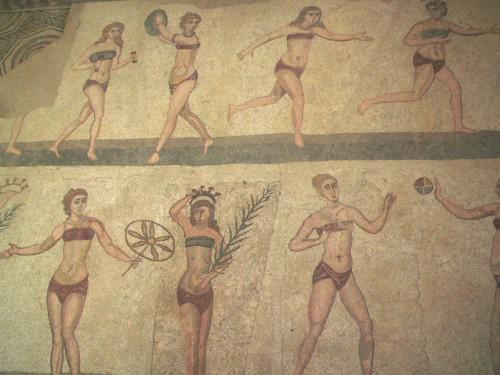 Let’s backpeddle to the first swimsuit: the bikini. Official history states the bikini was designed by French engineer Louis Réard in 1946. The swimwear is thought to be named after the Bikini Atoll, the site of several US atomic tests happening at the time. However, the bikini appears much earlier. A Roman mosaic dating the to the 4th century in Sicily shows Roman women exercising in quite modern-liking bikinis (Spivack, 2012).
Let’s backpeddle to the first swimsuit: the bikini. Official history states the bikini was designed by French engineer Louis Réard in 1946. The swimwear is thought to be named after the Bikini Atoll, the site of several US atomic tests happening at the time. However, the bikini appears much earlier. A Roman mosaic dating the to the 4th century in Sicily shows Roman women exercising in quite modern-liking bikinis (Spivack, 2012).
When the Roman Empire collapsed, bathing suits and bathing in general numbered among the collapse’s victims. Up until the 1500s, Europeans believed bathing spread disease rather than prevented it (Tousignant, 2014). Bathing didn’t return until the Renaissance and the Baroque period, and by then people expected female skin to remain covered. For example, in 1687, the English traveler Celia Fiennes described the typical lady’s bathing suit (Spivack, 2012):
The Ladyes go into the bath with Garments made of a fine yellow canvas, which is stiff and made large with great sleeves like a parson’s gown; the water fills it up so that it is borne off that your shape is not seen, it does not cling close as other linning, which Lookes sadly in the poorer sort that go in their own linning. The Gentlemen have drawers and wastcoates of the same sort of canvas, this is the best linning, for the bath water will Change any other yellow.
These bathing gowns sometimes had lead weights sewn into their hems so nothing would float up and reveal an ankle (Tousignant, 2014). Swim gowns persisted until form fitting bathing suits became popular in the early 1900s. Made of wool, these swimsuits covered from neck to ankle. In case you are wondering, men covered almost as much as women. They wore vests and swim shirts up until 1937, when they finally went bare-chested.
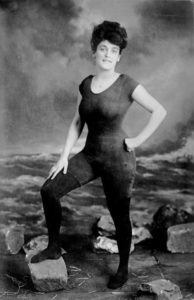
Anyway, these form fitting swimsuits caused a scandal. In 1907, Annette Kellerman, the first woman to swim across the English Channel, was arrested in Boston for wearing a form-fitting one-piece that showed skin on her arms and legs. Her arrest backfired. Instead of halting the trend of creeping skin, her arrest encouraged women to show more leg and and arm (Spivack, 2014). As the years passed, more skin appeared, but the invention of spandex marked the beginning of the modern, form-hugging swimsuits we are familiar with today.
The Japanese Modern Girl and Western Fashion
So what does the history of Western swimwear have to do with the Japanese school-girl one-piece? The answer traces back to the Meiji Restoration and the rise of the modan garu in the 1920s.
The Meiji Restoration marked the end of Japan’s closed-off feudal period and the start of rapid modernization. Japan looked to the West, particularly the United States, for examples. The rapid import of Western ideas sent shocks throughout Japanese society. One group in particular noticed a profound different in traditional views and Western views: women. Women became consumers of new Western forms of media: mass market magazines, movies, radio, jazz, and other imports. A small group of women began to emulate the Western fashions they witnessed in American movies. The modan garu, or modern girl, became the symbol of modernization.
As a symbol of modernism, you’d think the modern girl would be a common sight in the 1920s, just as the flapper was a common sight in America during the same decade. However, a 1925 survey of the Ginza area of Tokyo found 99% of women still wore traditional Japanese clothing. Only 1% of women dressed as modern girls. However, that 1% stood out. The modern girl wore bright-colored one-piece dressed that reached to her knees. She wore high-heeled shoes and sheer stockings that drew attention to her legs. Her bobbed hair was modeled after Hollywood actresses like Clara Bow and Gloria Swanson. The hair style in particular marked a significant change. Traditional Japanese women wore their hair in a bun, and an ordinance from 1872 forbade women from cutting their hair (Sato, 1993). Interestingly, during this period it wasn’t unusual for women to dive nude. Known as ama, this fisherwomen would become popular examples of the “Exotic East” for Westerners. They caused less of a stir than the modern girls.
So the modern girl was a woman who bucked tradition and embraced the Western fashion she witnessed on the silver screen. Among these fashions was the swimsuit. Postcards from the era sometimes showed Japanese women wearing Western style swimsuits. Swimsuits like the ones Kellerman wore. These women were at the height of fashion and controversy. Just as Kellerman ran into problems in Boston, Japanese modern girls faced backlash for showing too much and being too Western. The modern girl faced real challenges. Novelist Mochizuki Yuriko wrote an account of her experience as a modern girl when she cut her hair (Sato, 1993):
The long kimono was beautiful, but it was no longer in keeping with the age. Long Japanese hair was also beautiful, but that, too, had become anachronistic. Those were the feelings I had when I decided to cut my hair. . . . You can’t imagine the shock it gave to the people around me. My mother took one look at me and cried out in indignation, ‘You must be crazy! If you go out, everyone will call you one of those atarashii onna [new women]’-the term modan garu was not in use yet.. . . I remember another instance after I returned to my family home in the country. I ran into two girls, fifteen and sixteen, living in the neighborhood who had had a short cut. Ours was an extremely provincial, tradition-bound village, and it caused a great sensation. The girls were punished severely and their mothers sobbed and wailed, carrying on as if they were lunatics. My own mother confronted me and said, ’It’s your fault that this dreadful thing has happened. You’ve lost face with everyone in the neighborhood, so I wish that you’d just go right back to Tokyo.’ In no time I packed my bag and returned to Tokyo feeling as if I were escaping.. . . It’s been almost ten years since I got a short cut. During that time there have been a string of tragicomedies.
When I think back [to 1918], the painful experiences far outnumbered the comic situations. Even today, it’s appalling how many idiots jeer and hiss at me and are ignorant enough to label me a modan garu.
Japanese modern girls faced real problems for their decisions to embrace Western fashion. They not only faced problems with their families for breaking tradition, but they also faced the label of sexual deviant. Their embrace of Western fashion marked them as a sex object and women of poor sexual morality. Despite police investigations in 1923–which found nothing sexual or immoral going on in modern-girl cafes and other hang outs–the idea persisted. Some of this persistence is because of the exoticism of Western dress at the time. These women represented something new, different, and modern. In a word: exotic, and exotic women stimulate male libido–just as the ama and geisha did for Western men. The sexual attraction of the 1920s modern girl continues with the attraction for Japanese high-school one-piece swimsuits. Much like panty fetishes were caused by Westernization, the fetish for the one-piece started with the sexual objectification of early modern girls and their Western swimwear. And the association stuck.
Modan garu kept up with American fashion changes up until World War II. By the time the war ended, the American Occupation cemented America’s influence on Japan. However, there is another piece of the puzzle. The high-school one-piece isn’t merely a result of Japan copying America. The one-piece is distinctly Japanese. It resulted from the influence of the modern girl merging with the distinctly Japanese school uniform.
The Uniform Swimsuit
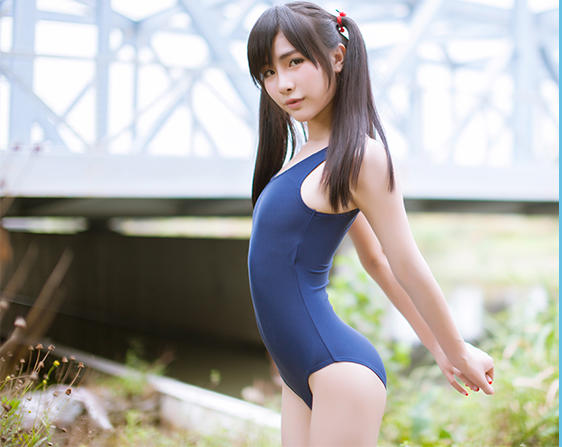
Besides the one-piece swimsuit, anime focuses on the Japanese school uniform. The Japanese school uniform, like the modern girl, came out of Japan’s rapid Westernization. Japanese school uniforms are as iconic as the samurai, and Japan engineered that iconography. When Japan entered the world stage, it was obsessed with how other nations perceived it. Japan wanted to present its military as modern, and military uniforms are the way to do just that. Military uniforms are designed to impress foreign nations, after all.
Japan took its modernization so seriously that it extended military dress to its school system. Female school uniforms were modeled after the Japanese Navy uniform, and male school uniforms were modeled after the Japanese Army. These uniforms were a way of advertising how Japan became modern across all levels of its population.
Beginning in the 1950s, school uniforms became associated with morally wholesome children. That is, until the Lolita movement and the push toward fashion started in the 1980s. During the 1980s, private girl schools began to use uniform styles to attract students. This pushed school uniforms into the public eye, including school swimsuits. In 1985, the book Girl Uniform Fieldbook by Mori Nobuyuki outlined various school uniform fashions and which schools featured each uniform (Kinsella, 2002). This, in combination with the shift in using school girl as advertising, brought the school uniform and school swimsuit back into the realm of sexuality. The long running strand of sexuality introduced by the modern girl back in the early 1900s had returned.
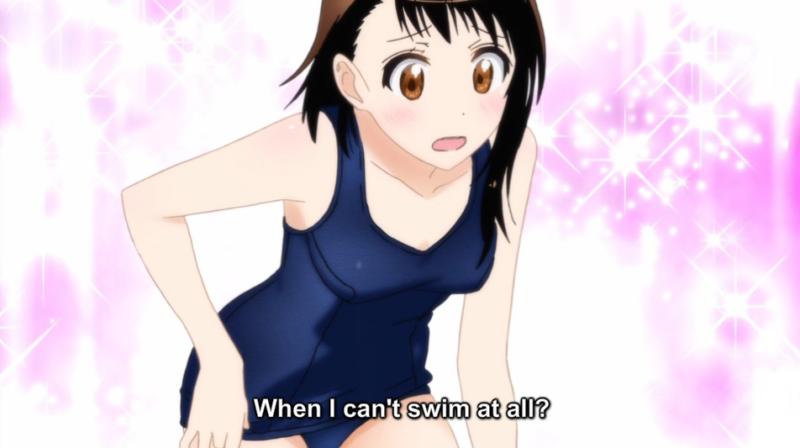
Anime picked up on this return of the swimsuit as a subject of sexual attraction. The one-piece became an iconic fetish because for many Japanese men it was the first exposure to the female body. First exposures leave lasting influence and tap into nostalgia. The one-piece dredges memories of high school and junior-high, times when you had more freedom. Nostalgia is a powerful feeling, especially when it is combined with sexual attraction.
The Japanese Male Swimsuit
So far, I’ve focused on the female one-piece. Although it is not as iconic, the male swimsuit shares similar DNA. However, it doesn’t the same potent sexual symbolism as the female swimsuit in popular culture. Some of this is because female sexual interests tend not to be as public as male. Marketing hasn’t capitalized on female sexual attraction as long as it has on male sexual attraction. This is changing as more marketing and anime aims at titillating women through male objectification. I’ve written about female objectification many times so I won’t get into it again here. If you want to read more check out these links: breast obsession, magical girls and sexism, otaku culture is sexist. The male swimsuit follows the same trail as the female. As women adopted Western fashion, awareness of Western male fashion also increased. Male swimwear has undergone fewer changes than female swimwear. Depending on your perspective, Westernized societies place a higher value on female skin than male skin. This is why males tend to have fewer controversy with swimwear. Female skin is more valuable as a commodity and therefore shouldn’t be shared as readily as male skin. For the record, I firmly disagree with this view, but patriarchal views hang on. This view is changing, however, as female sexual attraction and homosexual male sexual attraction becomes more accepted.
The Revenge of the One-Piece
Anime’s focus on the female one-piece swimsuit traces back more than a century, back to the opening of Japan to the rest of the world. For decades, Western fashion has influenced Japanese, but in recent years that has begun to reverse. The one-piece has returned in many American magazines. While the one-piece hasn’t completely disappeared, it played second-fiddle to the bikini. That is changing. In a 2015 article of InStyle, many women are returning to the one-piece as a backlash against the ever-shrinking bikini (Cheng, 2015).
I suspect Japan’s high school one-piece has had a small hand in this shift as well. Manga and anime enjoyed a period of booming popularity between roughly 2004-2008 here in the States. Many of these fans are now at an age where they can influence fashion. While anime and manga fans are a small cohort, their views cause ripples among nonfans. The constant exposure to one-piece swimsuits in anime and manga–not to mention how anime portrays the one-piece as sexier than bikinis–will shift ideals of fashion. I have to be clear: I don’t have data on this. It is merely a suspicion.
In any case, the one-piece swimsuit sits on a line of influence stretching all the way back through the Japanese modern girl movement, back through the swim gowns of yesteryear, back into the Roman Empire, and back even further into history. The one-piece shows how even a simple piece of material is connected to a web of ideas and people stretching back into time.
References
Cheng, A. (2015) Proof That One-Piece Swimsuits Are Now More Popular Than Bikinis. InStyle. http://www.instyle.com/news/celebrities-in-one-piece-swimsuits
Kinsella, S. (2002). What’s Behind the Fetishism of Japanese School Uniforms? Fashion Theory 6 (2). 215-238.
Sato, B. H. (1993) The Moga Sensation: Perceptions of the Modan Garu in Japanese Intellectual Circles during the 1920s. Gender & History. 3(3) 361-381.
Spivack, E. (2012). How Bathing Suits Went From Two-pieces to Long Gowns and Back. Smithsonian.
Tousignant, M. (2014). The History of Swimsuits, from Togas to Bikinis. The Washington Post. June 2, 2014.
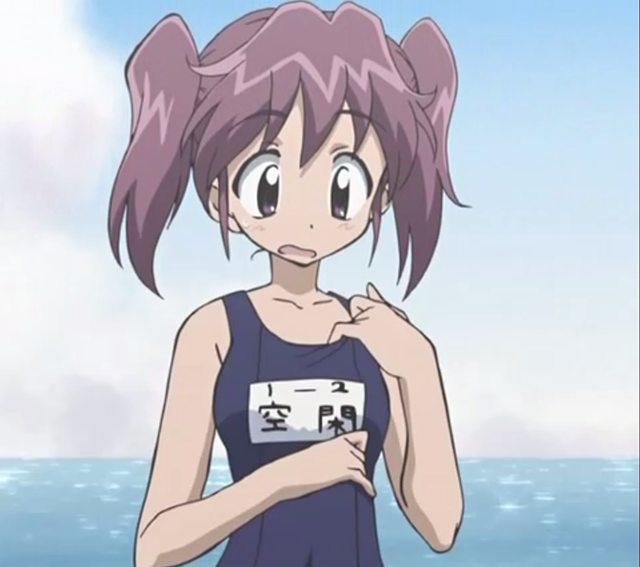
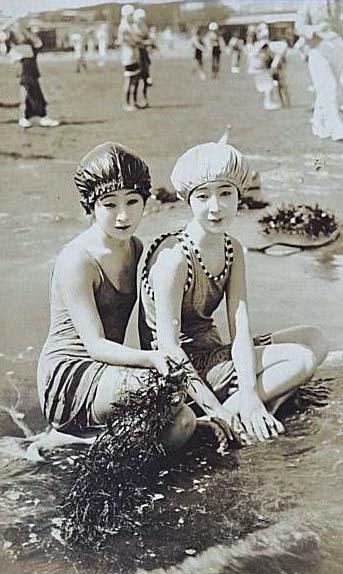
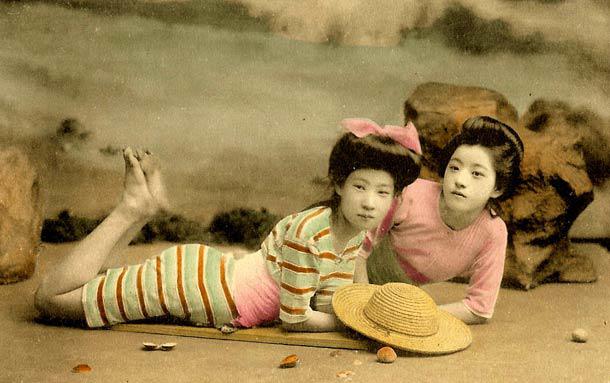
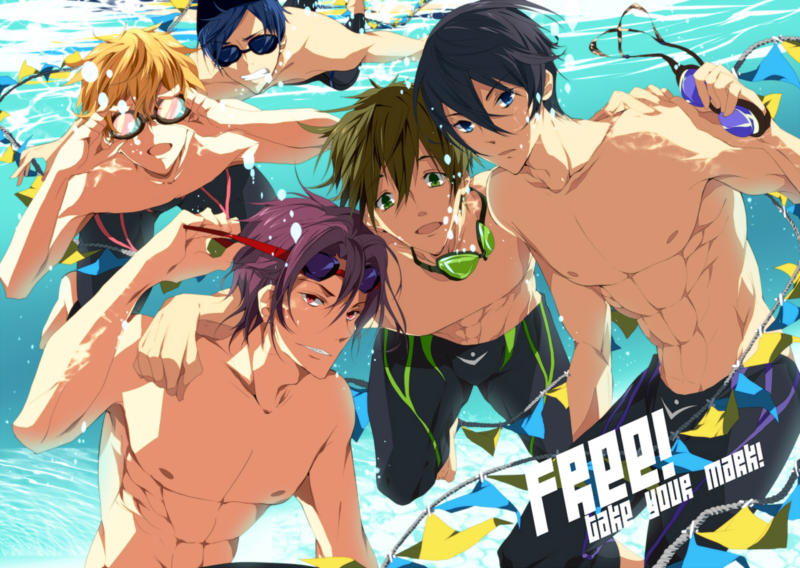
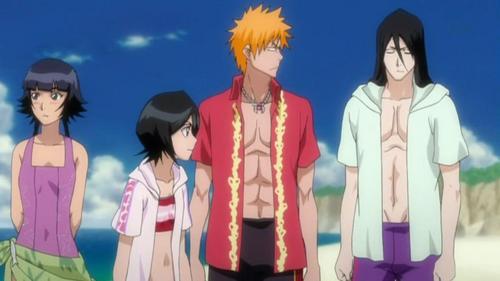



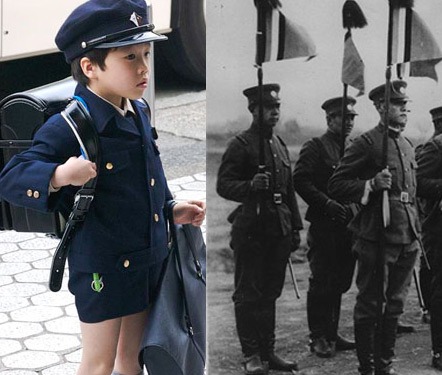


Really good post!
Thanks for the insightful article. I admit, I have fondness for the sukumizu, though that is 100% derived from my fondness of one-piece swimwear in general, for the reasons you’ve described at the very beginning; the “form-fitting, sleek” design is what makes them so special. Showing skin is only one part when it comes to a swimsuit; what is very important IMO is how the swimsuit makes the girl’s body look good, and the one-piece excels at doing that, regardless of age or body type.
To put it shortly, the swimsuit does a nice job at shaping and defining the body. The v-shapedness of the swimsuit “hugs” her figure, and at the same time exposes and showcases the waist, thighs and legs, all while also emphasizing both the butt and crotch by the way the swimsuit covers those parts. All while taking absolutely nothing away from the bare shoulders, bare arms, barefootedness, her lovely and pretty face, her beautiful hairstyle, and often a nice pair of breasts. The result is the girl looks astonishing graceful and beautiful at every pose from every angle.
I go further to say that if done correctly, a girl or woman will look better in such a swimsuit than she would look naked; the swimsuit is not worn to cover the girl’s body, but to complement it.
The specialty on how it carries over to anime is that fact that the characters are almost always free of body flaws that our real-life counterparts have. We’re obviously almost never going to see stuff like acne or pubic hairs or body fat on such characters like we may see on the local beach. To quote Ōkami-san and her Seven Companions, “It’s anime. Everyone looks good in a swimsuit.” And I think that’s what makes swimsuit episodes so popular in anime, manga, fan art, etc. Because the girls (and guys) look so good in them. The one-piece/school swimsuit is no exception to that rule.
Today, people have the mistake idea that baring as much skin as possible defines sexiness. As I study Japanese culture and history in general, I’ve learned covering skin does this more than baring skin. That which we can’t see interests us more than what we can see. As you mention, clothing can also help bodies meet cultural ideals of beauty. That’s why most male shirts and coats are cut in V-shapes, for example. Thanks for your comment!
Totally agree with you there. I’m glad anime gives a lot more love to one-piece swimwear (though it still seems second to the bikini like in real-life) and hopefully it’ll continue to do so and hopefully “will shift ideals of fashion” as you claim. Thanks for the reply!